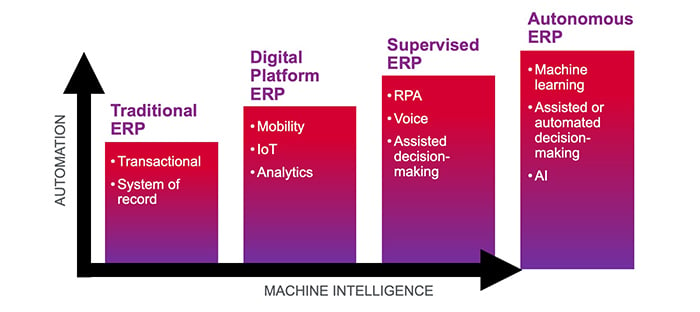Search for topics or resources
Enter your search below and hit enter or click the search icon.
April 5th, 2021
2 min read
By Tom Liptak

What's ERP? We get that question a lot from our friends and family. Gartner, the global research firm, coined the term in the 1990s to describe software that helped companies manage materials requirements and other back-office functions like HR and finance. Enterprise Resource Planning (ERP) has evolved since then. Today it incorporates manufacturing, sales, and marketing efforts as well. This postmodern ERP combines disparate databases into a single solution that’s accessible throughout an organization.
In 2013 Gartner predicted postmodern ERP would replace the version we’d all come to love or at least depend on. In this fourth evolution, ERP would shift to a combination of cloud-based and on-premises applications loosely coupled and easily replaced as needed. Operating with a postmodern ERP, businesses would be able to flex quickly in response to changing demands. They were right.
While some enterprises have been slower to adopt a postmodern ERP strategy, most are focused on that future. As these plans take shape, a solid foundation is essential to maintain visibility into each ERP level. Traditional ERP, like JD Edwards (JDE), remains the reliable system of record no matter the postmodern landscape. Whether on-prem or cloud-based, it helps businesses monitor and ensure data integrity across their SaaS solutions.

As an ERP consultancy, our role continues to evolve in tandem. We still help customers manage their traditional ERP, but also leverage functionality to integrate postmodern technologies. What does that really mean though? Here’s an example:
To start, we use an application monitoring tool to ensure our customer has a solid base to build on. It gives us real-time insights into JDE integrity. Then, we apply inherent functionality like orchestration/API to connect fluidly with third-party innovations.
Some solutions are designed by ERP Suites developers themselves and extend JDE’s capabilities. For example, ERP Suites Mobility gives salespeople the ability to access and edit customer data by smartphone. At the same time, ERP Suites Scanability empowers shop floor employees with mobile scanning functions. And our Document Automation solution converts paper forms to data eliminating manual entry. Each step in the postmodern ERP amasses more data than ever imagined making in-depth analytics essential. Tools like Oracle Analytics, Tableau, and Power BI help us identify trends.
What’s next? The fully cultivated postmodern ERP engages assisted decision-making solutions and embraces machine learning and AI. Today’s stretch technologies are tomorrow’s business priorities. To paraphrase Gartner, ERP is dead — long live postmodern ERP!
ERP Suites provides comprehensive technology solutions along the digital journey. We help companies not just identify IT’s potential but realize IT. Find ERP consulting support at erpsuites.com.
Tom Liptak is an Advisory Practice consultant at ERP Suites. Creative, agile and fluent in many tech languages, he helps customers get the most from their enterprise software. He excels in translating business needs into action and refining processes for ease and efficiency.
Topics: